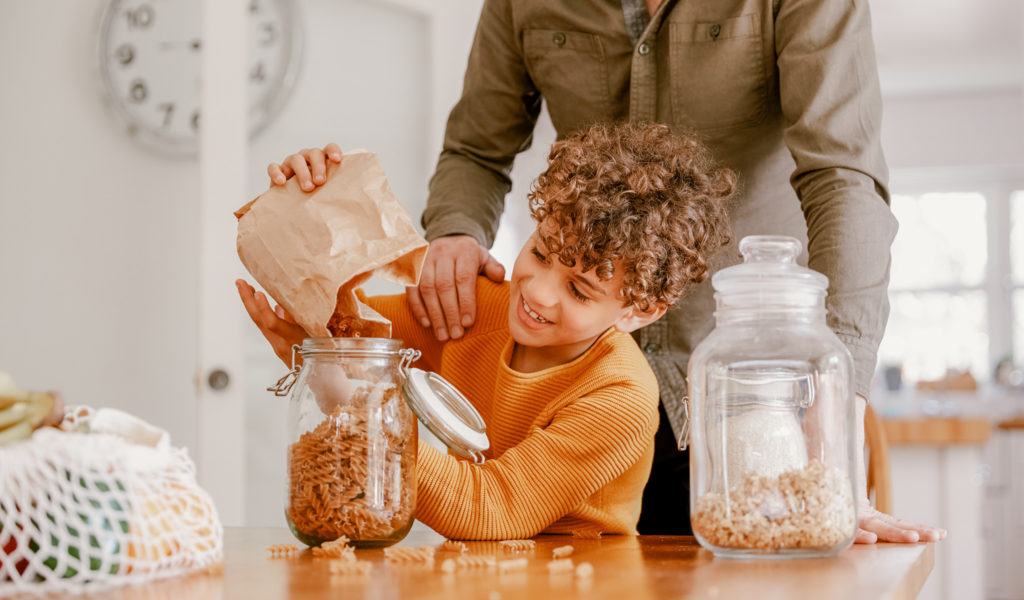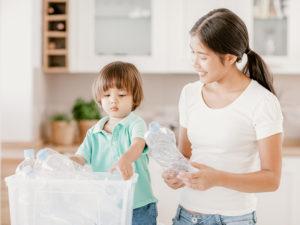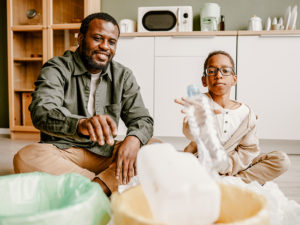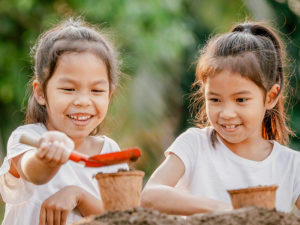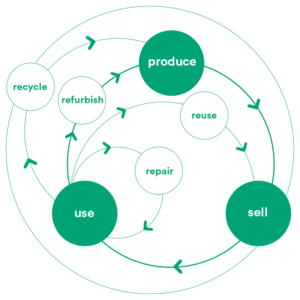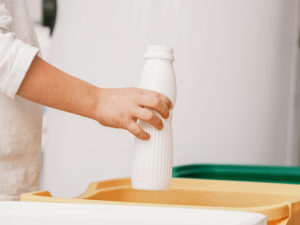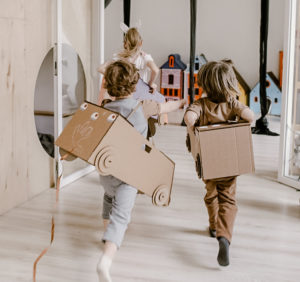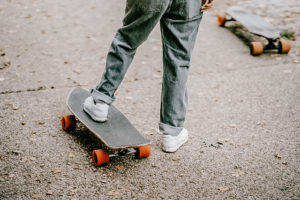Zero waste is an approach to living in which we strive to minimize the waste we generate. It encompasses everything from the homes we build, to the products we buy, the food we eat, and the way we move through the world. At its core, it is a logical, naturalistic idea which presents itself to us everyday in small choices; in the choice to drive or walk our kids to school; the food we shop for and how we prepare it; what trash we throw out in the evening.
We can begin to introduce the concepts behind reducing waste to our kids from a very young age, drawing on real world examples from their everyday lives without being didactic. If you feel that kids should just be left alone to be kids, we agree and posit that the two notions are not at odds. The natural curiosity that all children share is an ever-burning catalyst for acquiring new ideas.
How many times this morning has your four-year-old asked you “why”? Educating your child about zero waste doesn’t mean more homework, and it certainly doesn’t mean depriving them of anything. What it does mean is reducing waste in your life and encouraging your childrens’ natural curiosity to follow on that journey.
Zero Waste – The Why and The What
Before we go into more detail about how to explain zero waste to children, we ought to distinguish the why of zero waste from the what. The why should be abundantly clear from any direction by now. Whether we focus on the shocking 5% recycling rate of US household waste that leads to overflowing landfills and dangerous greenhouse gasses; our global reliance on non-biodegradable single-use plastics and fast fashion; or the continued mining of finite natural resources, the way we live now is destroying the planet.
The why of zero waste is a multi-disciplinary area of study, the tentpoles of which should be a part of our childrens’ formal education. However, the what of zero waste is something more tangible that can be acquired by children much earlier. It is what we do on a day-to -day basis to reduce waste that will have the most profound effect on our kids, and our planet.
So, while you can educate your children on climate change facts and encourage them to research chosen environmental issues for themselves, the what of zero waste is arguably more fundamental and more inclusive than the why. And perhaps a better place to begin.
The Mistake of Do as I Say, Not as I Do
There is no worse course of action in any educational endeavor than expounding ideas only to contradict them with your own actions. Children are renowned sponges and mimics. They can also spot a hypocrite a mile off. So there is no better way to teach a kid about zero waste habits than to enact them in your everyday life. The reverse is just as true. So let your child ask questions, and instead of reprimanding if you notice wasteful behavior, look at your own behavior and lead by example.
Like Charity, Zero Waste Starts at Home
Zero waste is most logical and intuitive at the level of the family home. For example, you can show your child why you store fresh produce in sealed containers—allowing us to eat it before it rots. You can begin zero waste activities without expressing their zero waste credentials. Just let them become a normal part of life.
You might choose to make your own laundry detergent to mitigate the upstream freight costs of shipping large quantities of liquid, but your kid will likely just see this as a fun hands-on chemistry experiment they do with their parents – one that has a practical application in their house. If they ask why you do it, you can explain. If not, the positive outcome is still valid and all will become clear over time.
Similarly, composting is a fascinating biological process in and of itself, and has an immediate and practical use in potting house plants or fertilizing a garden. Involve your child in that magical, regenerative process on its own merit. Again, the wider environmental benefits of composting can be explained as and when they are sought by the child. It needn’t be about relaying concepts so much as engaging in positive activities.
The Distinction Between Upstream and Downstream Waste
While the concept of downstream waste (e.g. your garbage going to landfill) is not a hard one to grasp, a young child may find it difficult to understand the notion of upstream waste within a circular economy. By upstream waste we mean the environmental impact of a product or service before it reaches us (e.g. the fossil fuels burned when turning silicon into silicone cupcake molds; the environmental impact of land that has been deforested in order to farm palm oil; or the freight emissions from a product shipped from overseas).
The negative impact is so far removed from their day-to-day use of the product, and the environmental benefits to avoiding it so intangible, that the idea is best left to older kids.
Giving Context to Zero Waste Activities
At a certain age, which you may be the best judge of yourself, you can begin to give context to some of the zero-waste choices and activities you are encouraging at home. While adults know that their trash goes to landfill and gives off methane, a younger child probably hasn’t thought much about where the garbage goes, let alone what negative effect it might have.
If your request not to toss something in the trash is met with a question or defiance, show your child what a landfill is—literally show them an image. There’s no call to wax lyrical about excess waste, or pepper them with statistics, simply introduce the idea that the things we use have a life after we hold them in our hands. Without placing the responsibility on a child, you can let ideas percolate organically about what implications this might have.
Take a Leaf Out of Their Book
Children tend to place greater value on their own possessions compared to an identical item that does not belong to them. Often our instinct with toddlers can be to fight the possessive streak that flares up around two to three years old, but it could be an opportunity to find additional uses for items we’ve come to think of as disposable.
Children don’t exhibit the same disregard for single-use plastic bottles or empty cardboard boxes as we do—anyone who has seen their child set aside an expensive new toy in favor of the box it came in knows how true this is. Parents should learn from our kids’ interest in repurposing everyday objects and encourage it. Do you really need to purchase that new toy, or could you fashion something new from existing materials alongside your child? In fact, what better way to go zero waste than by letting them take the lead?
Introduce the Idea of Their Carbon Footprint
While the last thing we want to do is introduce fresh anxieties to a generation already laden with them, the notion of a carbon footprint is a nimble concept that encapsulates much of the world’s waste streams and relates them back to the individual (or company). When your child is old enough to take a macro-view of environmental issues without being overwhelmed, this can be a useful place to start.
For example, we know that vehicle emissions are an area in which we can drastically reduce our carbon footprint. For a child, the notion that cycling or walking to the park instead of driving is helping to save the planet is a really powerful one.
So, while the focus needn’t be on the why to begin with, at some point showing your children that the little things they are doing are having a positive impact on the environment is empowering.
When explaining zero waste to children it makes sense to lead by example and begin with small actions in your everyday life. Let your children bombard you with questions once their curiosity is piqued and steer them in the right direction without lecturing.
Everything that older generations have had to unlearn and reconfigure and dismantle could be skipped over simply by pointing our children towards a less wasteful and more intuitive way of life while they are still young. Meanwhile, you can browse our blog for a host of tips and guidelines for going zero waste in everyday life.

